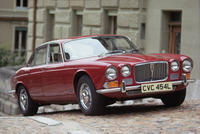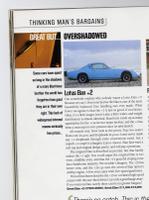 Yesterday evening I was killing some time by idly clicking my own AdSense ads, in a vain attempt to defraud Google to the tune of approximately $1.57, when I actually spotted an ad which grabbed my interest. (I suppose this is likely, given that my blog is about my interest and my ads are based on my blog. Anyway, I digress.) Under the broader heading of "Lotus Cars" there was a link advertising Lotus-specific track days run by a group calling themselves (in truly original fashion) Lotus On Track.
Yesterday evening I was killing some time by idly clicking my own AdSense ads, in a vain attempt to defraud Google to the tune of approximately $1.57, when I actually spotted an ad which grabbed my interest. (I suppose this is likely, given that my blog is about my interest and my ads are based on my blog. Anyway, I digress.) Under the broader heading of "Lotus Cars" there was a link advertising Lotus-specific track days run by a group calling themselves (in truly original fashion) Lotus On Track.This, I thought, sounded like a lot of fun. I read the introductions and the rules and it sounded even better. These cheery folk have a lot of good, safe enjoyment, in the company of their peers, out of harms way and without causing a nuisance to anyone. Then I clicked on the gallery and was slightly disappointed and surprised to see very few "classic" Lotuses. (Or should that be Loti?) Everyone was hurtling around in Lotus Seven kits or Elises/Exiges and there wasn't an original Elan in sight. Strange. Finally, I read the FAQ and things began to make sense.
If you own an irreplaceable classic like an old Elan, with which you have a certain affinity and don't particularly want to see mangled, reading advice such as this is not exactly going to encourage you to partake in the activity:
"... if you decide to take your car on to a track, you must be aware that you are accepting the risk ..."
Further examination reveals, depending on how much fun you have, you are likely to have to shell out for a set of tyres, some brake pads and an oil and filter change as a matter of course ... every time you go! And this note sends shivers down the spine of any sane, mortal, classic Lotus owner, knowing as you do that your engine is over 30 years old:
"... your engine will spend more time at high revs than ever before ..."
I don't know how much a Lotus engine rebuild costs, and I don't want to find out just yet (though I suppose it's inevitable I will one day). Track days are suddenly sounding less like the picnic I initially considered them to be.
All of the above leads to me only one possible conclusion. In order to thoroughly enjoy a track day, you have to be one (or more) of the following:
- Rich.
- A good home mechanic with ample access to inexpensive parts.
- Driving a hire car and insured to the hilt! (Something Lotus On Track won't let you do, probably on account of the fact you'll be driving like Jason Plato in the BTCC!)
It got me thinking it would be wonderful to be able to fix your own car like our friend Bob. His Fiat 500L is his pride and joy. He tells us he was the first person in the UK to do the now popular "Panda head conversion" (which is apparently neither cruel to animals nor illegal) making his 500L on 126 running gear good for 90mph.
I can tell you travelling at 60mph in an unmodified 500F - which is only possible downhill and with a following wind, by the way - is bloody terrifying, so 126 running gear or not, 90mph must be pure white-knuckle-inducing terror! The other day Bob apparently decided to push it a little. At an unmentionable speed (I wouldn't want to get the man in trouble) and egged on by his mate in an Alfa Romeo, the entire exhaust system sheered itself straight off the block.
"I'm an idiot," says Bob, "but never mind. I'll just fix it."
If I could say that, I'd be going to track days!



